[SOLVED] How many decibels does your computer make?
- Thread starter lvt
- Start date
You are using an out of date browser. It may not display this or other websites correctly.
You should upgrade or use an alternative browser.
You should upgrade or use an alternative browser.
- Status
- Not open for further replies.
Solution
I use the app Sound Meter on my Android phones, tested on two different phones (different brands) and the results are quite identical (+/- 0.5dB).
Thank you for this, I might take a look, however the primary reason for a dB measurement being higher or lower is the distance to the microphone.
If you measure at 1ft away with the screen of the phone facing the front fans on the PC and then did the same but 2ft away this difference will be significant.
The difference between 50 dB and 60 dB is 10x the measured level in dB as it uses a logarithmic scale.
https://en.wikipedia.org/wiki/Decibel
TheJoker2020
Reputable
How are you measuring this.?
What is the software, the microphone (phone), at what distance from the case, at what angle from the front on two axis, at what angle from the front is the microphone (phone) at on two axes.? I assume that the highlighted "A" is the weighting, which is a moot point without testing in the standardized methodology.
Without knowing these (and someone else having the same microphone), comparative results would be wildly inaccurate as there are far too many variables.
I would like to do a comparative test myself, but unless we have the same microphone (phone) and use the same methodology we would not be able to compare our results.
What is the software, the microphone (phone), at what distance from the case, at what angle from the front on two axis, at what angle from the front is the microphone (phone) at on two axes.? I assume that the highlighted "A" is the weighting, which is a moot point without testing in the standardized methodology.
Without knowing these (and someone else having the same microphone), comparative results would be wildly inaccurate as there are far too many variables.
I would like to do a comparative test myself, but unless we have the same microphone (phone) and use the same methodology we would not be able to compare our results.
My pc at anywhere close to idle is dead silent. Seriously inaudible above room noise. Gaming, I can barely hear it from 3ft away. Stress test is still quieter than the ceiling fan on medium.
But that's how I wanted it, so built it with that in mind. Some ppl have a need for that extra 5fps,the cost is louder fans. Some ppl have a need for the biggest cpu/gpu they can get, sacrificing everything else to do so. At the cost of louder fans.
It is what it is.
But that's how I wanted it, so built it with that in mind. Some ppl have a need for that extra 5fps,the cost is louder fans. Some ppl have a need for the biggest cpu/gpu they can get, sacrificing everything else to do so. At the cost of louder fans.
It is what it is.
How are you measuring this.?
What is the software, the microphone (phone), at what distance from the case, at what angle from the front on two axis, at what angle from the front is the microphone (phone) at on two axes.? I assume that the highlighted "A" is the weighting, which is a moot point without testing in the standardized methodology.
Without knowing these (and someone else having the same microphone), comparative results would be wildly inaccurate as there are far too many variables.
I would like to do a comparative test myself, but unless we have the same microphone (phone) and use the same methodology we would not be able to compare our results.
I use the app Sound Meter on my Android phones, tested on two diffrent phones (different brands) and the results are quite identical (+/- 0.5dB).
I assume that the highlighted "A" is the weighting, which is a moot point without testing in the standardized methodology.
The "A" is just a button to switch between text and graphical chart.
Mine's quite loud--5 out of 8 fans in my system is rated at 35dBA but I believe they are louder than that. The rest is audible on their own on full bore, the Yate Loon and pair of Scythes whir with added air rushing, the lone Deepcool fan I found lying around makes soft whir noise when turned up.
I don't mind since they're only noisy when I purposefully load the CPU with Prime95 small/OCCT small, and the fact that my background noise is quite high --have an old, noisy AC unit that hums audibly in my room.
I don't mind since they're only noisy when I purposefully load the CPU with Prime95 small/OCCT small, and the fact that my background noise is quite high --have an old, noisy AC unit that hums audibly in my room.
TheJoker2020
Reputable
I use the app Sound Meter on my Android phones, tested on two different phones (different brands) and the results are quite identical (+/- 0.5dB).
Thank you for this, I might take a look, however the primary reason for a dB measurement being higher or lower is the distance to the microphone.
If you measure at 1ft away with the screen of the phone facing the front fans on the PC and then did the same but 2ft away this difference will be significant.
The difference between 50 dB and 60 dB is 10x the measured level in dB as it uses a logarithmic scale.
https://en.wikipedia.org/wiki/Decibel
Thank you for this, I might take a look, however the primary reason for a dB measurement being higher or lower is the distance to the microphone.
If you measure at 1ft away with the screen of the phone facing the front fans on the PC and then did the same but 2ft away this difference will be significant.
The difference between 50 dB and 60 dB is 10x the measured level in dB as it uses a logarithmic scale.
https://en.wikipedia.org/wiki/Decibel
Thanks for the info, I would make some more tests before deciding whether to install a second intake fan at the front.
With the current 12cm blowing at full speed, I have the CPU temperature reduced by 2 or 3°C and the HDD by 2°C.
If I can reduce the CPU temperature by 5°C with both fans blowing, I think I would live with the noise.
hotaru.hino
Glorious
These are my findings. The first image is where I sit from, which is roughly two feet away from the computer. The second is with the phone right up against the front panel. The case is a Fractal Meshify C with two Noctua 140mm intakes.
System idle
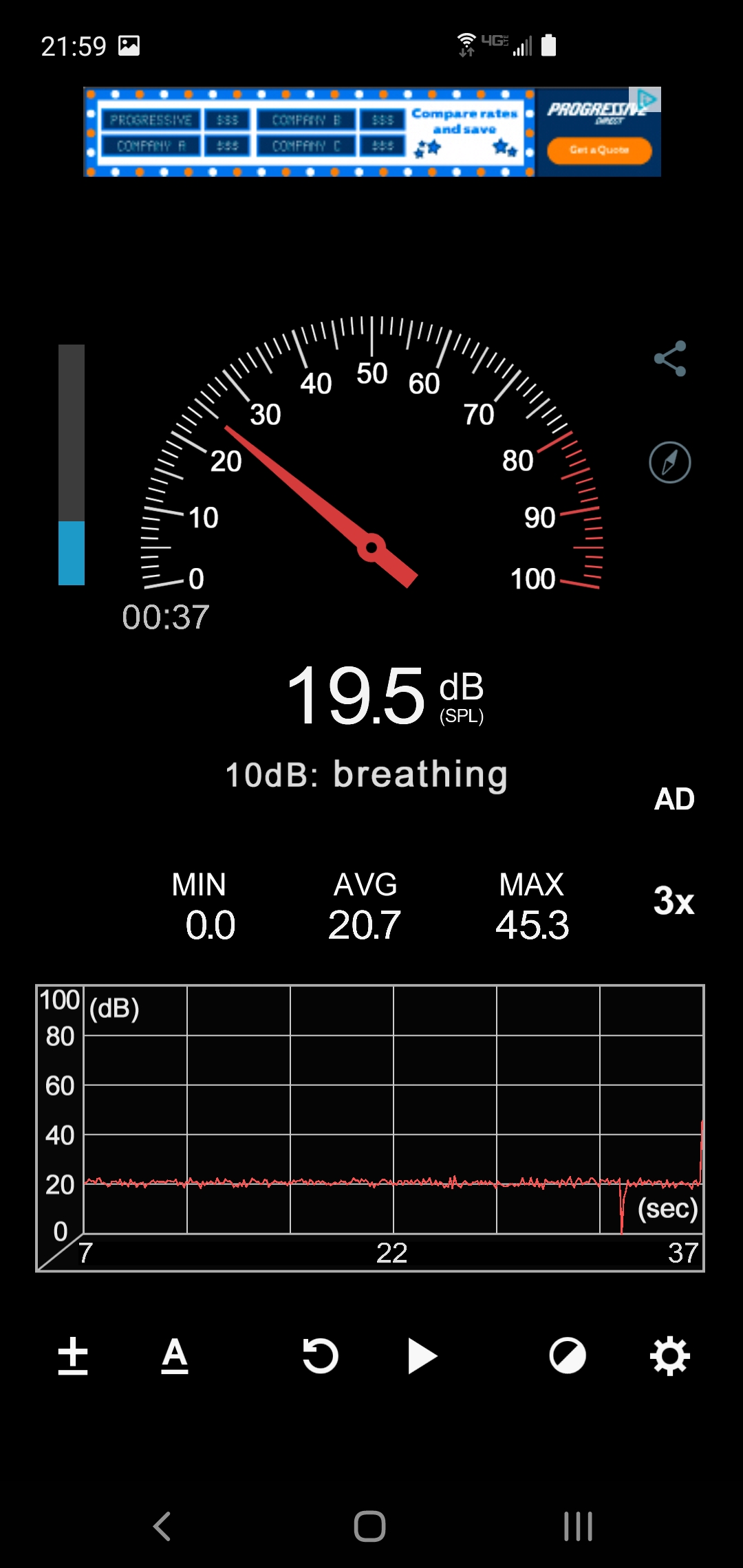
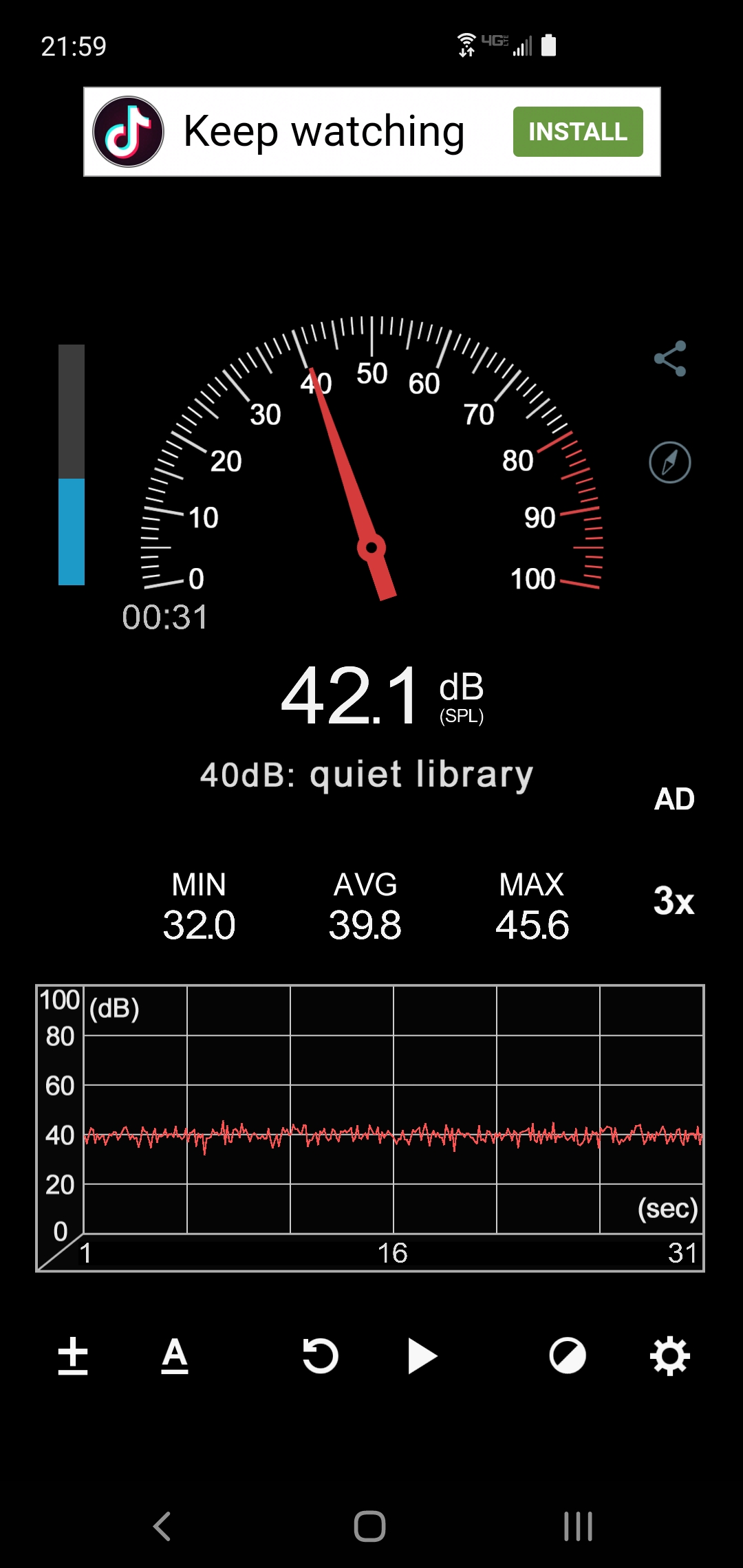
Game (Minecraft RTX)
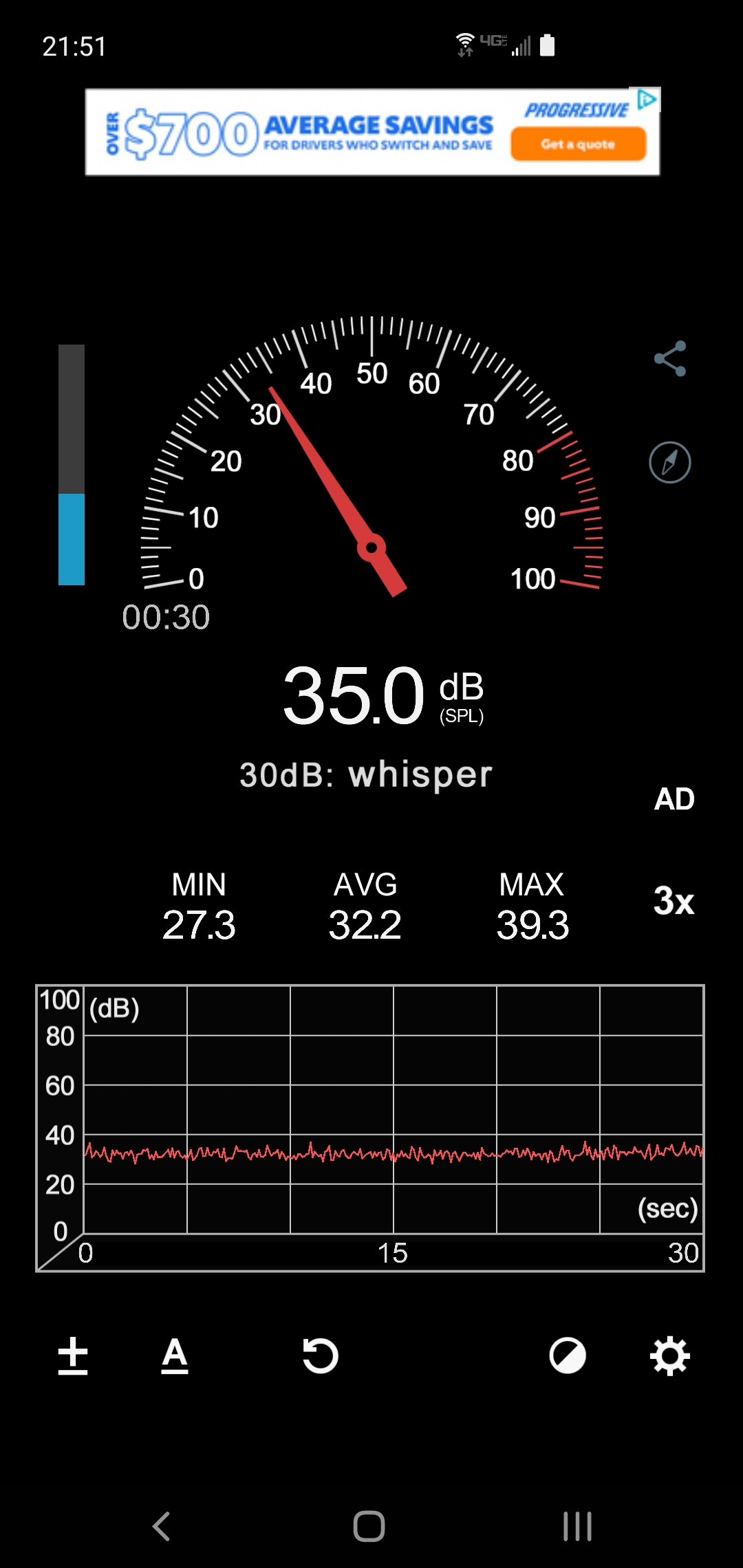
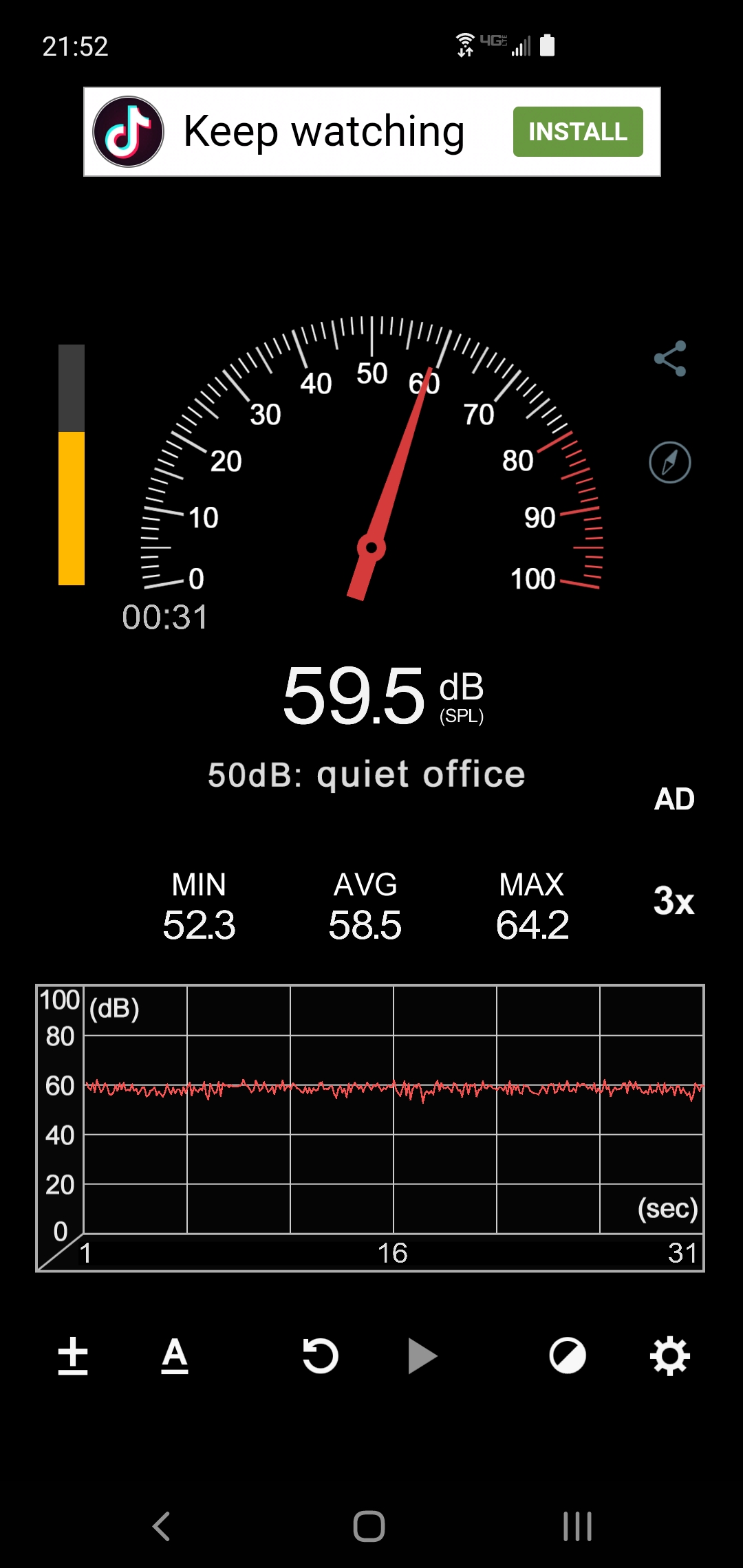
Room is about 26C. CPU floats around lower 50s C while the GPU floats around lower 60s C.
System idle


Game (Minecraft RTX)


Room is about 26C. CPU floats around lower 50s C while the GPU floats around lower 60s C.
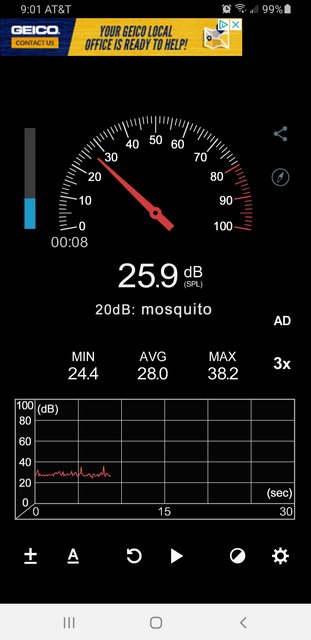
Idle: 38°C. Taken 2" from rad intakes.

Idle: 38°C. Taken from where I sit.

Prime95 Blend 16t. 56°C. Taken from where I sit.
That's with the ceiling fan running at medium settings, 16 ft away.
If you take the time to figure airflow characteristics, fan designs, fan curves, cooling requirements etc, it's entirely possible to build an absolutely quiet system. But you have to throw out pre-conceived notions, assumptions etc and figure out your exact scenario, and not totally rely on others findings but use them as tools to better equip your understanding.
hotaru.hino
Glorious
Something to share.
If there's also a common thread I've seen with low noise builds that can keep power hungry components tamed without getting loud, it's the following
- Straight airflow paths. Which makes sense to me. The path of least resistance is a straight line
- Low fin density heat sinks. Or at least something you don't see in a GPU cooler. Higher density means more impedance
- As we know, larger fans mean more air going through for less RPM.
Aircooling is All about efficiency. Not so much capacity. The Noctua NH-D15 has 250w+ capacity, but at @ 150w use, the much smaller NH-U12S has higher efficiency and gets better temps than its big brother. It's what sets coolers apart, the Arctic esports duo is also highly efficient, blows away a CM hyper212 for roughly the same price and less noise.
Out of curiosity I tried the app, and the results are suprising to me.
Note that my background noise is quite high; measured at 58.1dB, and I sit right next to my desktop, about a feet or bit less away. I did it just now as it is just past midnight and the rest of the house is as quiet as can be.
Found that under full-bore, synthetic power test from OCCT, I see "only" 60.3dB maximum recorded value. Pretty sure there's something I did wrong, but the analogue for "quiet office" seems about right. There's the hum of AC unit, and the faint whirr of the fans.
Note that my background noise is quite high; measured at 58.1dB, and I sit right next to my desktop, about a feet or bit less away. I did it just now as it is just past midnight and the rest of the house is as quiet as can be.
Found that under full-bore, synthetic power test from OCCT, I see "only" 60.3dB maximum recorded value. Pretty sure there's something I did wrong, but the analogue for "quiet office" seems about right. There's the hum of AC unit, and the faint whirr of the fans.
TheJoker2020
Reputable
I just measured my PC from where I am sitting, so the sound level as I hear it.
I bumped into a few problems.
The first is that it was picking up my breathing, I had it about 9" in front of my nose, whilst I was seated in my typical position, I had to breath very shallowly, this can be easily fixed by me positioning the phone where my head would be and moving away a distance for the measurement.
The second is that I had two PC's on, I turned off the noisier of the two (a Brix) and the overall sound level measured did not change at all, but it was clearly obvious to me, so it looks like I will have to do some testing with the dB measurement levels.
My final problem was that I used the built in option and e-mailed myself what I thought would be a screengrab, it sent me a URL for the software 🤦♂️
I do not have any screengrab software on my phone (I run it with minimal software and maximum restrictions), what screengrab software would you recommend for Android that is free and would be suitable for this App.
PS: The dB readings were bouncing around between 16 and 22 mostly, and higher than that breathing normally.
I bumped into a few problems.
The first is that it was picking up my breathing, I had it about 9" in front of my nose, whilst I was seated in my typical position, I had to breath very shallowly, this can be easily fixed by me positioning the phone where my head would be and moving away a distance for the measurement.
The second is that I had two PC's on, I turned off the noisier of the two (a Brix) and the overall sound level measured did not change at all, but it was clearly obvious to me, so it looks like I will have to do some testing with the dB measurement levels.
My final problem was that I used the built in option and e-mailed myself what I thought would be a screengrab, it sent me a URL for the software 🤦♂️
I do not have any screengrab software on my phone (I run it with minimal software and maximum restrictions), what screengrab software would you recommend for Android that is free and would be suitable for this App.
PS: The dB readings were bouncing around between 16 and 22 mostly, and higher than that breathing normally.
That's the difference between db and db(A).
Your perception is squewed. The phone is measuring actual noise levels, but what your ears actually hear is frequency levels. You can have a speaker at a certain db level, add an identical speaker and it only raises the level by 3db, but to your ears it's much louder.
Same with your pc's, the actual noise level might not change by shutting down the 'noisy' one, but in reality all you've done is silence the more obvious frequency to your ears.
60Hz is usually assumed to be the lowest end of human hearing. That's the heavy punch from a subwoofer. You can have that at 40db sound pressure level (spl) and it's very obvious ans sounds loud. 30Hz is more felt than heard, that's the rumble you feel in the seat when it hits. At 40db spl, you'll still not really hear it, but you'll for sure feel it.
So noise volume will differ from noise level, according to perception.
Your perception is squewed. The phone is measuring actual noise levels, but what your ears actually hear is frequency levels. You can have a speaker at a certain db level, add an identical speaker and it only raises the level by 3db, but to your ears it's much louder.
Same with your pc's, the actual noise level might not change by shutting down the 'noisy' one, but in reality all you've done is silence the more obvious frequency to your ears.
60Hz is usually assumed to be the lowest end of human hearing. That's the heavy punch from a subwoofer. You can have that at 40db sound pressure level (spl) and it's very obvious ans sounds loud. 30Hz is more felt than heard, that's the rumble you feel in the seat when it hits. At 40db spl, you'll still not really hear it, but you'll for sure feel it.
So noise volume will differ from noise level, according to perception.
TheJoker2020
Reputable
Your perception is squewed. The phone is measuring actual noise levels, but what your ears actually hear is frequency levels. You can have a speaker at a certain db level, add an identical speaker and it only raises the level by 3db, but to your ears it's much louder.
So noise volume will differ from noise level, according to perception.
Well put in fewer words than I could even attempt to, which is also why I was measuring from where my head is positioned, if I crawled around under the desk, then yes it would be louder, sound different and also be a pointless exercise for testing as I would not be testing against anything (plus my first tests were quite flawed (I had to breathe)).
NOTE, the Brix is on top of the desk over 3ft away with a monitor partially obscuring it and is still relatively quiet, but makes its noise via a small blower fan that is a higher pitch. I do need to sort out my ridiculous rats-nest of wiring, so at some point I will move the Brix to a better position.
Windows22
Prominent
Good question.How are you measuring this.?
What is the software, the microphone (phone), at what distance from the case, at what angle from the front on two axis, at what angle from the front is the microphone (phone) at on two axes.? I assume that the highlighted "A" is the weighting, which is a moot point without testing in the standardized methodology.
Without knowing these (and someone else having the same microphone), comparative results would be wildly inaccurate as there are far too many variables.
I would like to do a comparative test myself, but unless we have the same microphone (phone) and use the same methodology we would not be able to compare our results.
- Status
- Not open for further replies.
TRENDING THREADS
-
-
Discussion What's your favourite video game you've been playing?
- Started by amdfangirl
- Replies: 4K
-
My PC won't shut off this ugly red RGB light — my motherboard has become my biggest aesthetic annoyance
- Started by Admin
- Replies: 11
-
Question Windows is using Microsoft Basic Display Adapter ?
- Started by Corbin8756
- Replies: 89

Space.com is part of Future plc, an international media group and leading digital publisher. Visit our corporate site.
© Future Publishing Limited Quay House, The Ambury, Bath BA1 1UA. All rights reserved. England and Wales company registration number 2008885.

